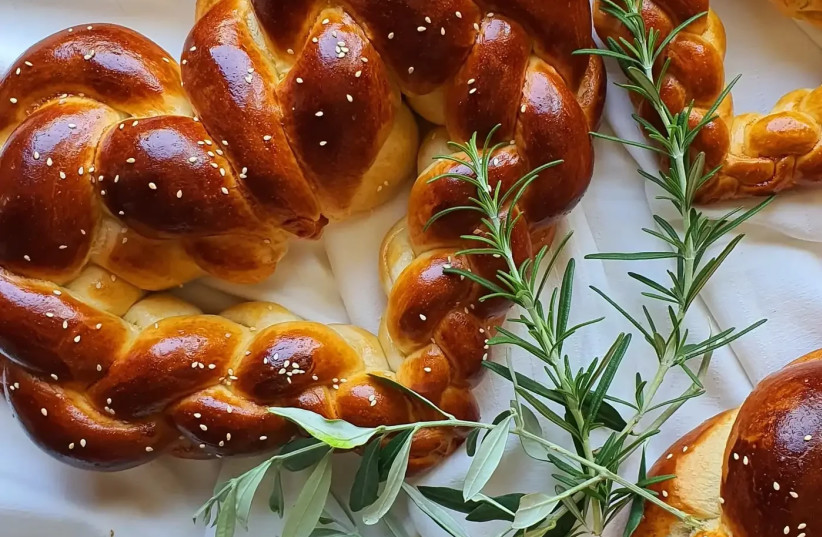Idan Chabasov (also known as the "Challah Prince") is gearing up for his sixth concert tour in the United States, solidifying his status as a shining star from Israel.
The tour is set to kick off at the end of November. In these troubling times, Chabasov's focus is on spreading light and love through his challah creations. He plans to incorporate Jewish symbols like the Star of David and the flame of Chanukah in his challah designs, bringing warmth and comfort to his audience.
Chabasov found himself in Israel during the recent Black Shabbat surrounding Gaza.
Despite the challenging circumstances, he has been doing his part by collecting donations and baking challah for soldiers and evacuees.
"I see everyone around me giving and doing what they can. It helps me deal with the situation psychologically and strengthens me as a person," he said.
'Unofficial ambassador'
Chabasov has also taken on the role of an unofficial ambassador for Israel, receiving support from his contacts in the United States. While he has lost some followers since the conflict began, he remains focused on his mission to support Israel.
With a loyal following of 350,000 people, Chabasov has been creating challah in various shapes, including the Star of David and hearts.
These designs provide both comfort and enjoyment for his audience. Chabasov has received numerous requests to share his techniques, prompting him to host a live workshop in collaboration with the "We Are Together" project, organized by the Museum of the Jewish People (Anu) and its culinary wing, Foodish.
During the workshop, Chabasov demonstrates how to create a Star of David challah and a heart-shaped challah, allowing participants to explore the creative side of this ancient art form.
For those interested in trying out Chabasov's challah recipes, here is a simple one to get you started:

Ingredients (for one large challah)
Dough
1 kg (7 cups + 2 tablespoons) bread flour
100 grams (1/2 cup) white sugar (those who prefer less sweet challah can reduce up to half the amount of sugar)
20 grams (1 tablespoon) fine salt
14 grams (3 teaspoons) of dry yeast (or 40 grams of fresh yeast)
100 grams (1/2 cup) olive oil or sunflower oil
430 grams (¾1 cup + 1 tablespoon) water
Coating
2 beaten egg yolks
Sesame
Preparation
1. Prepare and rise the dough: mix flour, sugar, salt and dry fennel in a mixer bowl with a kneading hook. If using fresh yeast, do not add it at this stage but dissolve it in 1/2 cup of the water.
2. Add oil and water (if using fresh yeast, add the dissolved yeast as well) while kneading at a slow speed. Put for about 4 minutes, until the flour absorbs all the liquid (you may not need all the water). The resulting dough should be neither sticky nor wet, but it is important that no flour deposits remain at the bottom of the bowl.
3. Increase the speed of the mixer to medium and knead for 10-12 minutes, until you get a smooth, uniform dough that gathers around the kneading hook and detaches from the sides of the bowl.
4. Remove the dough from the mixer bowl, dribble and transfer to a greased bowl. Cover with a plastic bag or a damp and clean towel and leave to rise outside the refrigerator for about an hour, until the dough doubles in volume.
5. Shape, puff and bake the challah: heat the oven to 180 degrees and line an oven tray with baking paper. Divide the dough into 8 equal balls weighing about 200 grams each (there is no need to flour or oil the surface).
6. Take one of the balls of dough and flatten it a little using the base of the palm against the work surface, to form an oval. Fold the long side of the oval to the center and roll it to form a cylinder. Place your hands in the middle of the roll and roll it while moving your hands from the center to the ends of the roll, until you get a strip of dough 60-70 cm long, thicker on one side and narrower on the other. Roll the rest of the dough in the same way.
7. Place 4 strips of dough side by side on the work surface, with their narrow part close to us and the thick part away from us. Connect the thick ends together. Number the strips from right to left - the rightmost strip is number 1, the leftmost strip is number 4. Please note: as soon as you change the position of one of the strips, the numbering changes accordingly (the rightmost strip will always be number 1 and so on).
Place strip 2 on top of strips 3 and 4 so that it becomes the leftmost one.
Place strip 1 above strip 2, between strips 2 and 3.
Place strip 3 on top of strip 1, so it becomes the rightmost.
Place strip 4 above strip 3, between strips 3 and 2.
8. Repeat the operation until you braid a long braid, the upper part of which is thick and the upper part is narrow. Fasten the narrow edges of the dough, so that the challah does not open during swelling and baking.
9. Knit the remaining 4 strips in the same way.
10. Place the two strips in the pattern, facing each other, and shape each braid into a half-heart shape, so that the two braids form a heart whose "hills" are plump and whose "tip" is thin. Cover with plastic wrap or a clean towel and leave to rise for 40-60 minutes, until the dough almost doubles in volume.
11. Spread the puffed challahs with egg yolk and sprinkle with sesame seeds. Bake for 25-30 minutes, until golden brown on all sides.
